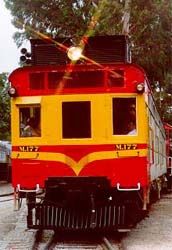 |
The Headlight
Southern California Scenic Railway Association, Inc.
The mission of the Southern California Scenic Railway Association
is to provide and administer volunteers and to raise and manage
funds to focus public awareness on Southern California rail history and promote railroad safety
|
Volume 16, Number 4 | Winter 2001
|
|
By Sue Kientz, SCSRA President
Donation Pays Off M.177 Engine Loan
At the tail end of 2001, M.177 received an anonymous cash gift, which will be matched by the donor’s place of employment, for a grand total of $7,600. This gift is specifically earmarked for paying off the loan on M.177’s engine. What this means is, as soon as the check comes in for the matching company’s share, all associates who loaned us funds to bring back the engine will be paid in full, and SCSRA will have paid off the M.177 engine rebuild completely!
Fullerton Track Move Nearly Complete
This is especially good news since we have spent quite a bit of our funds moving all our track material to Fullerton. That job is 98 percent complete, with mostly cleanup taking place now. Due to some rain days and equipment failures, we again requested an extension until January 31 for us to finish the scrapping and disposal of the remainder material which we just don’t need or want. So while we had reserved the equivalent of M.177’s engine payoff funds in our accounts, we no longer have to do so since receiving this most generous gift. I’m sure all of you join me in thanking this anonymous donor who has taken quite a load off all our shoulders.
Our track material at Fullerton is, at press time, now
newly fenced and protected.
We now look forward to working on a proposal for a new spur
for the Fullerton Railway Plaza Association (FRPA), for their
upcoming Fullerton Rail Road Days, May 4-5. There is even the
chance that we will be doing track work demonstrations at Rail
Road Days. More to come on this in the next issue.
SCSRA Ideas Well Received at FRPA Dinner
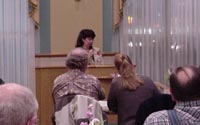 At the past FRPA Quarterly Dinner Meeting, I delivered a speech which gave an update of our association’s activities, and then addressed the different ways SCSRA and FRPA can work together to realize the dream of a real first-class Southern California Railroad museum in Fullerton. Dick Hopping, FRPA’s president, told me later that my speech was very well received, and that his entire group is so pleased that we are interested in helping them realize their very worthy goals.
At the past FRPA Quarterly Dinner Meeting, I delivered a speech which gave an update of our association’s activities, and then addressed the different ways SCSRA and FRPA can work together to realize the dream of a real first-class Southern California Railroad museum in Fullerton. Dick Hopping, FRPA’s president, told me later that my speech was very well received, and that his entire group is so pleased that we are interested in helping them realize their very worthy goals.
Interim Permit at Travel Town Considered “Still Extended”
While it seemed that the City of Los Angeles allowed SCSRA’s permit to expire at the end of December, I have since learned that City representative Linda Barth considers our permit still in force on a month-to-month basis. When it was extended in June 2001, it was extended with all terms. Apparently the six-month duration of the Interim permit is not being considered one of those terms. Linda also has informed us that the City will not agree on any Caboose Train Operations for 2002 because of Train Shed construction (even though Train Shed will not break ground, supposedly, until March or April 2002). So effectively our train operations activities are no more, at least for the time being.
M.177 Back on Motor Trucks
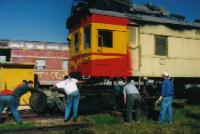 One final bit of good news to round off this report. In early January, Bryan Reese’s jacks were extracted from under M.177, and the motorcar is again on its trucks and can be moved as needed. Thanks to our ever-faithful Saturday volunteers, Dan Price, Jeff Barrow, Doug Stephens, Gordon Bachlund, George Engelage (he’s getting to be somewhat of a regular!), Don Schuster, and Mike Vitale leading the pack, we got the job done without ANY cash outlay for a crane or anything else. See Doodlebug Notes for more on this story.
One final bit of good news to round off this report. In early January, Bryan Reese’s jacks were extracted from under M.177, and the motorcar is again on its trucks and can be moved as needed. Thanks to our ever-faithful Saturday volunteers, Dan Price, Jeff Barrow, Doug Stephens, Gordon Bachlund, George Engelage (he’s getting to be somewhat of a regular!), Don Schuster, and Mike Vitale leading the pack, we got the job done without ANY cash outlay for a crane or anything else. See Doodlebug Notes for more on this story.
I don’t know about you, but this already seems like a Happy New Year to me!
Click pictures for enlargement
By Gordon Bachlund, Chief Mechanical Officer
I am sad to report little progress on the M.177 during the past months. By way of explanation, (1) we spent a lot of time getting organized and tidying up the mess in the boxcar, and I am now pleased to report that, thanks to Doug Stephens and the M.177 Team (Dan Price, Jeff Barrow, Don Schuster, Michael Schuster, Mike Vitale and Darlene Sexton) we are finally well organized; and (2) we lost considerable momentum when all hands undertook to move our rail and signal assets to Fullerton, a move that, hampered by several rainy days, grew to take up the better part of November and December, as well as early January. It had to be done, though, and I am proud of what we have accomplished under the increasingly unfriendly circumstances at Travel Town.
Also, Mrs. Barth queried several of us individually about the paint that we were planning to apply to the roof, and that exercise in nitpicking feckless bureaucracy cost us even more time.
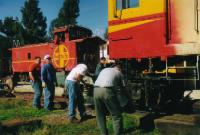 However, we can point to one very major accomplishment. On January 5, Mike Vitale spearheaded a team effort to replace the power truck beneath the front end of the M.177, thereby getting the car back on its own wheels and off the cribbing on which it had rested uncertainly since November 2000. I am grateful to George Engelage for technical assistance, and to Dan Price, Jeff Barrow, Doug Stephens, Don Schuster and Sue Kientz for their help, and most especially to Mike for doing an outstanding job of planning and supervising.
However, we can point to one very major accomplishment. On January 5, Mike Vitale spearheaded a team effort to replace the power truck beneath the front end of the M.177, thereby getting the car back on its own wheels and off the cribbing on which it had rested uncertainly since November 2000. I am grateful to George Engelage for technical assistance, and to Dan Price, Jeff Barrow, Doug Stephens, Don Schuster and Sue Kientz for their help, and most especially to Mike for doing an outstanding job of planning and supervising.
Lastly, I am excited to report that we received an anonymous donation of $3,800 toward the M.177 Fund. This magnanimous gift will be matched in mid year by the donor's employer. Anonymous donor, whoever you are, we thank you most profusely! Your kindness will enable us to retire the longstanding loans that made the return of the Winton engine possible.
Click pictures for enlargement
|
* * * MEMBERS AND GUESTS ONLY EVENT * * *
MOVIE NIGHT:
The General
Saturday, Feb 16, 2002
With Live Piano Accompaniment
Social, 6:30 p.m., Movie 7:00 p.m.
at
Sue Kientz/Ron Baalke Residence
Gordon Bachlund and his Movie Crew will present the silent Buster Keaton classic with Greg Smith at the piano. Also included will be a featurette and full-length cartoon.
Wear warm clothes and, if possible, bring a lawn chair!
RSVP by February 10
Hope to see you there!
|
PART THREE: How Do You Make a Caboose into a Hotel Room?
In the previous installment, we read how Donald M. Denlinger of Soudersburg, PA, found a home for 19 cabooses and a diner car that he came by along the way. He squeezed them into their new siding, but how is he going to turn the cars into hotel rooms?
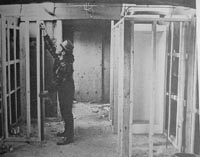 When all cars were in place, the task of interior renovation began. The carpenters had to swap their saws and hammers for cutting torches, welders, and jack hammers. They did not know that every railroad coach has about three inches of concrete on the floor to provide a low center of gravity needed while traveling along a track at 80 miles per hour.
When all cars were in place, the task of interior renovation began. The carpenters had to swap their saws and hammers for cutting torches, welders, and jack hammers. They did not know that every railroad coach has about three inches of concrete on the floor to provide a low center of gravity needed while traveling along a track at 80 miles per hour.
The contractors had their work cut out for them. Every time they drilled through the floor for a water line or sewer connection, they were defied by an air tank or vacuum valve in the way. They soon learned that a silly little millimeter oftimes made quite a difference.
The next shock came when the fiberglass showers arrived and wouldn’t fit through the 22-inch caboose doors. To solve the problem a 36 x 36 inch hole had to be cut into the side of each caboose. After passing the showers through, the holes were welded shut and the showers installed.
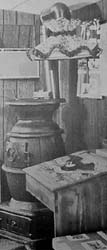 One of Denlinger’s nostalgic concepts of what should be inside a caboose was a potbelly stove. He was amazed to learn that there were none to be had. He called and visited many companies that had manufactured such stoves but found they just didn’t make them anymore. A few were eventually located; but they were either too short or too narrow and, anyway, he needed 30.
One of Denlinger’s nostalgic concepts of what should be inside a caboose was a potbelly stove. He was amazed to learn that there were none to be had. He called and visited many companies that had manufactured such stoves but found they just didn’t make them anymore. A few were eventually located; but they were either too short or too narrow and, anyway, he needed 30.
Denlinger then learned of a factory in North Carolina which was rumored to have potbelly stoves still in production. A phone call proved that the firm had 30 stoves in stock. When Denlinger told them that he would take them all, there was no question in the mind of that salesman — he had either a madman or a drunk on the phone. Serious negotiating soon convinced the sales representative that Denlinger meant business. It took only a week for the seven tons of stoves to arrive on the motel site.
Denlinger’s interior design of the caboose motel units had to make every inch count. Since the potbelly stoves were not to be used as heaters (the units are heated electrically), Denlinger devised a unique application for the rustic pieces. He immediately set out in search of precisely the right size television set to fit inside the stove.
A light was needed for over the desk beside the stove so guests might address post cards from their Pennsylvania Dutch home for the night. What more unique than a lampshade mounted in the elbowed stovepipe?
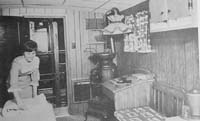 Denlinger spent many hours going through furniture catalogs looking for a combination desk, settee, chest and chair. He shopped in vain. Making a sketch of exactly what he wanted, he took it to a Pennsylvania Dutch cabinetmaker in Paradise. The craftsman accepted the challenge, dovetailed the corners and came up with a marvelous piece of functional furniture tailored to the motel demands.
Denlinger spent many hours going through furniture catalogs looking for a combination desk, settee, chest and chair. He shopped in vain. Making a sketch of exactly what he wanted, he took it to a Pennsylvania Dutch cabinetmaker in Paradise. The craftsman accepted the challenge, dovetailed the corners and came up with a marvelous piece of functional furniture tailored to the motel demands.
Two local Mennonite ladies made the curtains from railroad pattern material, and a neighbor woman fashioned pillows from the same material to complete the decor.
Time was running out. Some reservations had been accepted for opening day. But the day before the opening, bad weather made it impossible to move the bedding and furniture into the units.
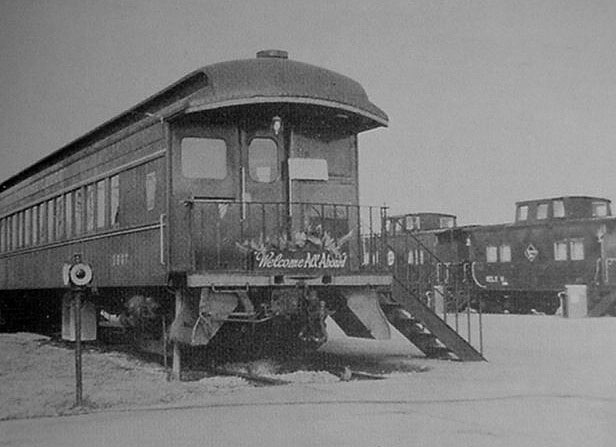 The next day the site resembled a madhouse. Plumbers, carpenters, carpetlayers, and cleaning ladies ran collision courses, each trying to ready enough units to accommodate the reservations. They didn’t quite make it and some of the early arrivals had to wait in their cars while the beds were made up and curtains were hung.
The next day the site resembled a madhouse. Plumbers, carpenters, carpetlayers, and cleaning ladies ran collision courses, each trying to ready enough units to accommodate the reservations. They didn’t quite make it and some of the early arrivals had to wait in their cars while the beds were made up and curtains were hung.
The official Grand Opening and Open House was scheduled for Mother’s Day of 1970. The local newspaper and radio coverage of all the problems and heartaches connected with the development of the project had created much public interest. In five hours on that Sunday, 4,500 people toured the caboose units.
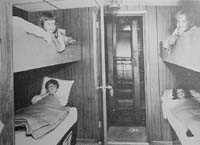 Children loved them and pleaded with their parents to come and spend a night. Parents agreed and many made reservations for a future night away from home.
Children loved them and pleaded with their parents to come and spend a night. Parents agreed and many made reservations for a future night away from home.
There were problems that day, but they were happy ones . . . parking and traffic jams.
The dining car proved the main attraction with its plush Victorian railroad furnighings such as the shining brass pullman lanterns contrasting handsomely with the red flocked ceiling and red velvet curtains enriched with gold tassels.
The seats of old-fashioned Bentwood ice cream parlor chairs beckoned behind gold ropes.
Railroad sound effects completed the enchantment as the unique stereo system poured forth sounds of collected railroad songs, distinctive whistles and some full steam recordings compiled into special tapes.
Visitors were soon lost in a nostalgic dream. From one window they could see an Amish buggy trotting by and when they looked out the other window, the hissing and puffing of the huge Strasburg steamer passing on one of its scheduled runs to Paradise. The Strasburg Steam Rail Road is a daily operation carrying tourists and does not run after sundown. The sights and sounds were enough to make one forget the troubles of the world.
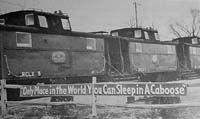
No one could argue that Mr. Denlinger did, indeed, have his troubles in getting the Red Caboose Motel onto the right track, but exclamations of praise for the completed project and reservations in number above expectation have more than complensated for the tribulations which preceded them.
Since the opening of the Red Caboose Motel, one of Denlinnger’s greatest pleasures has been enjoying the unique attraction through the shared experiences of his guests.
Next Issue: The Story of the Red Caboose Motel continues with stories of visitors reactions and experiences, like the couple who were convinced their caboose hotel room was moving! Also, accounts of how other cabooses joined the hotel when word that Denlinger would truck unwanted ones off for free made the rounds. Until next issue, see The Red Caboose website
By Jeff Barrow and Dan Price, Maintenance of Way Co-Superintendents
WOW!
Such a simple word, only three letters long, yet so perfectly summing up the events of the five days between the 21st and 26th of November, 2001. These days marked a turning point in the life of the SCSRA, a time of muted sadness, a time of exuberant joy. Over these few days the many trucks laden with Maintenance of Way material rolled passed the Travel Town gates, never to return. It was the start of our exodus, away from what had become an uncaring and oppressive home.
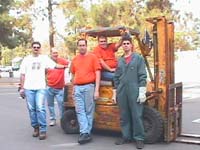 The writing had been on the wall for quite some time; however in mid-October the edict had been issued from on high and Linda Barth ordered us to remove our track and signal materials from Travel Town. Everything, it was ultimately decided, that was track and signal was ours to remove. As the weeks rolled by we prepared everything for transport and moved it into the parking lot.
The writing had been on the wall for quite some time; however in mid-October the edict had been issued from on high and Linda Barth ordered us to remove our track and signal materials from Travel Town. Everything, it was ultimately decided, that was track and signal was ours to remove. As the weeks rolled by we prepared everything for transport and moved it into the parking lot.
On the evening of Wednesday the 21st and continuing on Thanksgiving morning, the last of the material to go on the first trips was moved to the parking lot and rearranged for fast loading. The time until the first material would leave was now hours, not days away. Needless to say there was much to be thankful for at dinner that evening.
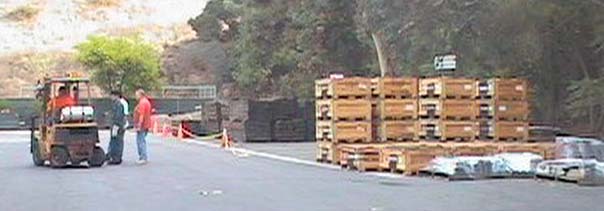
The rumble of diesel engines, as two 24’ stake trucks and a 35’ flatbed semi truck rolled into the parking lot, broke the calm of Friday morning at Travel Town. The time to leave was at hand. The first truck to leave was one of the two rental trucks from Suppose-U-Drive of Glendale.
Everyone waved as Jerry Price sounded the horn and drove the first load out of sight. However, there was no time to waste on celebration, as our United Rentals reach-forklift was frantically loading the semi-truck with rail. Bob Perrson, President of Borrmann Steel in Burbank, California, graciously donated the use of the semi that made this weekend possible. (See
The First Rail Load!)
While work was progressing at Travel Town, work was also going on at Fullerton. The area allotted for storage was approximately 35’ by 125’ and needed to be cleared before the trucks began arriving; quick work was made of the concrete ties and other track hardware. Sadly, the only injury of the weekend occurred when Gordon Bachlund had his finger smashed by a wayward concrete tie. Thankfully the doctors report he will be able to use a lighter to light his trademark cigars again in no time.
Back at Travel Town, Murphy’s Law attacked our efforts as the brakes on the rented forklift gave out. We were panicked as we called United Rentals, trying to get a mechanic or replacement forklift as soon as we could. While we waited, the semi truck driver, Bill Sundy, came to our rescue and skillfully operated the SCSRA-owned forklift to load one stick of rail at a time onto the truck. Quick work was made and soon the first load of 50+ sticks of rail was also on the road. The second stake truck shortly followed the semi; we were on a roll.
The remainder of Friday was spent frantically loading trucks and sending them on their way. United Rentals, after some prodding, sent a mechanic who was able to perform an ad-hoc repair that gave us some brakes through the end of the weekend. This enabled us to ultimately take two loads of rail, roughly 106 sticks, on the semi truck and 5 loads of ties and other material between the two stake trucks. The last of the volunteers finished unloading trucks in Fullerton at about 8 p.m. that night. Everyone was tired; at the same time everyone was also eager for the next day and proud of the work that had been accomplished.
The dawn greeted a cold and cloudy Saturday morning. Rain was coming and everyone knew it was going to be a wet and miserable day. However, once again our turnout was very strong and everyone was ready to work. We were able to take six loads between our two stake trucks, even though much of the loading and unloading was done in the pouring rain. Additionally, work continued on preparing pallets for loading onto trucks. Sadly, the rain took its toll and the last volunteers working in the rain at Travel Town, Mike Vitale and Doug Stephens, were dragged kicking and screaming into the Shop. However, once inside it was not hard to convince them to have an indoor lunch until the trucks returned.
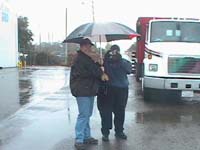 As at Travel Town, the rain was also pouring in Fullerton, leaving the crew there also looking like drowned rats. They were forced to take shelter under the awning of an adjacent industrial building to avoid the worst of the weather. By the time the final load was on the highway, heading towards Fullerton, the sky had begun to clear, Sunday would be a good day. Almost all the ties had been taken from the park, as had much of the miscellaneous track hardware. Like Friday night, unloading the trucks in Fullerton continued into the night. By the end of the day we were again exhausted.
As at Travel Town, the rain was also pouring in Fullerton, leaving the crew there also looking like drowned rats. They were forced to take shelter under the awning of an adjacent industrial building to avoid the worst of the weather. By the time the final load was on the highway, heading towards Fullerton, the sky had begun to clear, Sunday would be a good day. Almost all the ties had been taken from the park, as had much of the miscellaneous track hardware. Like Friday night, unloading the trucks in Fullerton continued into the night. By the end of the day we were again exhausted.
Sunday brought sunny skies and the optimism for one more big push. The first truckloads left with the last ties and more track hardware. While they were en-route work continued at Travel Town preparing the last of the track hardware for transport. 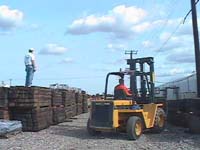 Additionally, the last of the large track and signal material from the Zoo Drive storage area was moved into the parking lot for movement in the near future. By the end of the day five truckloads of track hardware had passed out of Griffith Park. Even being the end of the holiday weekend, traffic was not very bad and we made it home from Fullerton earlier than any of the other nights.
Additionally, the last of the large track and signal material from the Zoo Drive storage area was moved into the parking lot for movement in the near future. By the end of the day five truckloads of track hardware had passed out of Griffith Park. Even being the end of the holiday weekend, traffic was not very bad and we made it home from Fullerton earlier than any of the other nights.
By the end of the weekend a total of 18 truckloads (16 on the stake trucks and 2 on the semi truck) had been moved to Fullerton. Work would continue through the end of January, but this first weekend had been the biggest push, and set the pace for the entire project.
See The Complete Collection
of images and movies from Thanksgiving Weekend
By Sue Kientz
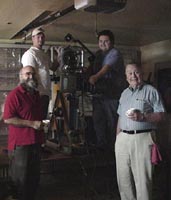 On December 15, SCSRA associates migrated to Pasadena for the annual Christmas Party and the first of what may be many movie nights in Sue Kientz’s roomy, four-car garage.
Gordon Bachlund and his film crew of Jim Hoffmann, Tim Dulin, and Tom Graham (pictured at right) set up a 35mm movie projector on a riser that Jim brought in his truck, with the target being a rented screen at the back of the garage.
On December 15, SCSRA associates migrated to Pasadena for the annual Christmas Party and the first of what may be many movie nights in Sue Kientz’s roomy, four-car garage.
Gordon Bachlund and his film crew of Jim Hoffmann, Tim Dulin, and Tom Graham (pictured at right) set up a 35mm movie projector on a riser that Jim brought in his truck, with the target being a rented screen at the back of the garage.
After a well-received dinner of ham, lasagna, and salads, accompanied by hot cider, the assemblage was entertained with a vintage short subject on train safety, a Road Runner/Wiley Coyote cartoon, some of which takes place on a track and in a train tunnel (big surprise — at least for the coyote!),
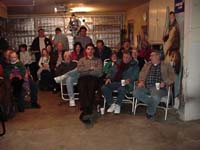 and then the feature presentation, Trading Places, starring Eddie Murphy and Dan Ackroyd. The movie was delightful, and fun was had by all. It wasn’t even that cold in the garage!
and then the feature presentation, Trading Places, starring Eddie Murphy and Dan Ackroyd. The movie was delightful, and fun was had by all. It wasn’t even that cold in the garage!
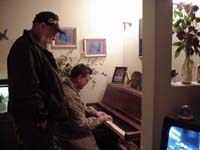 Afterward, Greg Smith (at right, seated) and Mike “Oatmeal” Flaherty (behind him) took over the piano in the family room. Greg played some wonderful Christmas Carols, and Mike entertained us with some real boogie-woogie music. (Greg will be displaying more of his musical talents this coming movie night in February, when he will be playing accompaniment to the silent movie The General. We hope you come to that event, again at Sue Kientz’s house; see Movie Night for details.)
Afterward, Greg Smith (at right, seated) and Mike “Oatmeal” Flaherty (behind him) took over the piano in the family room. Greg played some wonderful Christmas Carols, and Mike entertained us with some real boogie-woogie music. (Greg will be displaying more of his musical talents this coming movie night in February, when he will be playing accompaniment to the silent movie The General. We hope you come to that event, again at Sue Kientz’s house; see Movie Night for details.)
As the film crew tore down their projector setup, Sue and her boyfriend Ron led a pack of die-hards up Christmas Tree lane to see the large deodar trees covered in Christmas lights. The lights go on for many blocks, and as they trudged on, the smarter party-goers passed them in cars, enjoying the lights in warm comfort. Of course, they didn’t get the exercise, or the opportunity to be in Elliot Alper’s night-vision video of the event.
Thanks to all who helped, and all who came and made our Christmas party another memorable time together.
See The Complete Collection
of images and movies from The SCSRA Christmas Party
By Jeff Barrow and Dan Price, Maintenance of Way Co-Superintendents
After the Big Thanksgiving Weekend Move, there was much more prep to be done to complete the moving of the remaining MW materials, i.e., sorting through many miscellaneous signals and crossing protection hardware. This was all that was left after the first loads of materials, consisting of 95% of all our salvageable track materials, went down to Fullerton.
To outline our adventures, there was the big weekend move, then a few weeks of prep, then another smaller move, followed by about a month of prep, finally all ending up with another large move weekend on January 12-13.
The smaller move in between was done by loading up a truckload of crossing gate assemblies driven down to Fullerton by Jeff Pippenger. At the Fullerton end our rental forklift did not live up to the standard that had to be met for driving heavy loads over ballast, so we had to just set things down whereever we could.
Our final big move was on January 12th, as Jeff Pippenger hauled a dump truck and flatbed truck of the last track and signal material to Fullerton. During this move we also recovered a 75# frog that had been inadvertently taken and returned it to Travel Town. One last trip with Gordon Bachlund’s pickup and Doug Stephen’s pickup rounded out the weekend carrying some loose pieces that remained at Travel Town.
At press time we have about two weekends of work left to complete the move. We will use the long weekend over Martin Luther King Day to finish gathering scrap steel, loose railroad ties, and trash. The following week the scrap steel will be removed. That weekend we’ll haul our trash to the landfill and haul the loose railroad ties and any other material to Fullerton. By the time you read this we should be done.
Over this past quarter we have done what many within Travel Town had likely considered impossible; what we moved in the short three days the trucks were running is simply unbelievable. This unbelievable feat was made doable through the tireless dedication that the volunteers of the SCSRA showed in this time of need. The majority of the prep work was completed with the shear endurance of a core group of workers: Daniel Price, Jeffrey Barrow, and Doug Stephens. These people barely had a Christmas and a New Year because they were out there just about every day loading pallets, packing boxes, banding materials, etc. Besides them there were other consistent workers:
|
Gordon Bachlund | Jeff Barrow | Tim Dulin |
|
George Engelage | Tom Graham | Jim Hoffmann |
|
Dick Hopping | Sue Kientz | Jeff Pippenger |
|
Daniel Price | Jerry Price | Jamie Rhea |
|
Tim Riley | Chris Rippy | Don Schuster |
|
Annette Sevigny | Darlene Sexton | Greg Smith |
|
Doug Stephens | Mike Vitale | Dug Ward |
We would also again like to especially thank Bob Perrson, President of Borrmann Steel, and Jeff Pippenger for their assistance in arranging trucking of our material.
Thank you all, you made this possible. Go Team!
See The (more or less) Complete
Collection of Images and Movies from The Other Weekends
By Gordon Bachlund, Mechanical Superintendent
Diesel Shop — The City’s direct volunteer has made some attempts to maintain Charley Atkins, but in December it required “jump starting” on operating days. As SCSRA Operations essentially ended on December 22, 2001, this will be our last “Diesel Shop” report until we are up and running elsewhere with our own locomotive which we will properly maintain, as we used to the City’s locomotives.
Battery Servicing — Replacement of the caboose batteries continues to be investigated. The existing batteries are being given periodic equalizing charges and are still barely serviceable.
However, since our Operations at Travel Town ended on December 22, 2001, our emphasis now will be to get the cabooses moved from Travel Town to a temporary storage location where we can have them repainted, reupholstered and serviced in preparation for future Operations.
Stay tuned....
By Gordon Bachlund
In the last issue I described my excellent volunteer experiences at the Railtown 1897 Historic Site in Jamestown, and I compared the sadly deteriorating situation at Travel Town to the wonderful successes at Jamestown. What a difference a people-oriented management makes!
Now, permit me to tell you a little about a long held dream of the SCSRA — participation in the establishment of a “world class” railroad museum in Southern California — and about another group with a similar dream, the Fullerton Railway Plaza Association (FRPA).
About 12 years ago, Linda Barth assembled a working group of SCSRA and ASRA volunteers, and other railway preservation specialists, into a “think tank” to generate a revision to the Travel Town Master Plan originally authored by Walter Gray and Steven Drew of the California State Railway Museum. The result was supposed to be the genesis of a “world class” railroad museum. It was that noble goal that kept the SCSRA alive for more than ten years.
Late last year several SCSRA directors and officers attended an FRPA dinner meeting at which FRPA President Dick Hopping outlined his group’s vision of establishing a “world class” railroad museum, a Southern California version of the State Railway Museum at Sacramento. Thanks to the pro-active leadership of SCSRA President Sue Kientz, the SCSRA and the FRPA are considering an agreement wherein the SCSRA is offering its assets and talents in a partnership with the FRPA. Our goals are the same, and together we will make them come true. The new museum bears a tentative name, the Southern California Railway Museum at Fullerton, and models and master plans already exist, and preliminary contacts have been made, so this is far from being an idle dream.
This begs the question, which of the above enterprises do you think will be the first to realize its goal? In my mind, the FRPA/SCSRA partnership will, hands down. Why? Because both groups know how to show their appreciation for those who volunteer for its activities, who after all are the ones who keep the dream alive and vibrant.
By James G. Hoffmann, Operations Superintendent
Dropping the Fire — As everyone probably knows by now, the City of Los Angeles declined to approve a schedule for any public operations beyond the end of 2001. This is mostly due to the anticipated startup of Train Shed construction, which will necessitate relocation of all rail equipment stored east of the pedestrian walkway on Tracks 5-8. Construction is scheduled to begin in March; we asked if the City wanted us to provide Operations in January and February, but were told no.
Accordingly, I have issued a Bulletin nullifying Timetable No. 3 and all previous Bulletins. This means that the Operating Department is officially in hiatus until further developments. It is anticipated that we will start up operations of some kind in Fullerton at a future date.
I would like to thank each and every one of our dedicated Associates who “kept the faith” and helped bring the era of SCSRA’s operations at Travel Town to a safe and successful close. During the past twelve years you helped carry more than 100,000 passengers with a perfect safety record! How many other demonstration railroads (let alone “real” railroads) can match that claim?
From Chief Instructor’s Desk — Owing to the restrictions placed upon us by the City, and the need to use all our resources in relocating track materials, there was no activity during the quarter.
Our public operations were held October 6th and 7th, November 3rd and 4th, and December 1st and 2nd, and our final public operations took place on December 22 (pictures and MPG movies available). I was unable to attend, but I got the information from Santa Fe Claus:
| Operating Day | Passengers | Donations |
|---|
| Saturday, October 6 | 327 | $ 243.97 |
| Sunday, October 7 | 149 | 73.00 |
| Saturday, November 3 | 355 | 241.20 |
| Sunday, November 4 | 387 | 49.14 |
| Saturday, December 1 | 263 | 187.70 |
| Sunday, December 2 | 216 | 120.61 |
| Saturday, December 22 | 270 | 149.64 |
| Total: | 1,967 | $1,065.26 |
| Total to date: | 109,125 | $47,801.82 |
Operating Days: 187
Blast from the Past — It was a special treat to see Randy Matus appear near the close of Operations on the 22nd. Some of you may not know Randy; he was my predecessor as Operating Department Superintendent. Shortly after SCSRA began offering public rides it became apparent that if Operations were to succeed more Associates with operating experience would be needed. Randy took on the task of organizing the Department and really got the ball rolling. He contacted numerous people whom he knew from his days at Orange Empire Railway Museum (including the writer) and got us interested in operating at Travel Town. After his job made increasing demands on his weekends (he is now an Amtrak engineer), Randy was forced to give up his volunteer work. (He was a Board Member and president in addition to his superintendence.) Thanks, Randy, more than you can ever know, for leaving me such a fine foundation to continue building upon!
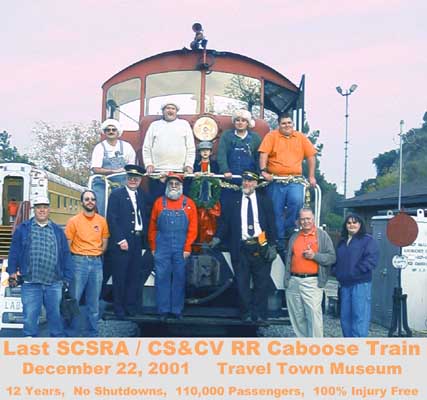
Honor Roll — It is my intention to publish an all-time roster of the entire department, to be included in a future issue of The Headlight. As I am still working on this list, I will have to be content to list the usual quarterly Honor Roll for now:
Gordon Bachlund, Jeff Barrow, Mike Flaharty, Charles Forsher, Sue Kientz, Charity Lawrence, Randy Matus, Dan Price, Don Schuster, Mike Schuster, Annette Sevigny, Darlene Sexton, Mike Vitale, Dug Ward, and Alan Weeks.
Again, a huge THANK YOU to everyone who made Operations a success!
THE HEADLIGHT
is published quarterly at Los Angeles, California, and is the official publication of
THE SOUTHERN CALIFORNIA SCENIC RAILWAY ASSOCIATION, INC.
P.O. Box 39727, Griffith Station, Los Angeles, CA 90039-0727
(323) 667-1423 and via the World Wide Web at http://www.scsra.org/
A California Nonprofit Public Benefit Corporation, Incorporated January 4, 1984
IRS Tax Exemption No. 95-3947766

Any article or feature published in The Headlight may be reprinted in whole or in part provided that proper credit is given the source.
BOARD OF DIRECTORS
Chair, Gordon Bachlund (January 2007)
Members,
George Engelage (July 2006)
Sue Kientz (July 2005)
Ted McConville (January 2005)
Jerry Price (July 2005)
Jim Vicars (January 2006)
CORPORATE OFFICERS
President, Sue Kientz (July 2002)
Secretary, Greg Smith (July 2004)
Treasurer, Mike Vitale (July 2003)
APPOINTED OFFICERS
Vice President, Corporate, Gordon Bachlund
APPOINTED SUPERINTENDENTS AND MANAGERS
General Superintendent, Jerry Price
Chief Mechanical Officer, Gordon Bachlund
Mechanical Superintendent, vacant
Asst. Supt., Gas & Diesel Locos, vacant
Asst. Supt., Steam Locomotives, vacant
Asst. Supt., M.177 Project, Doug Stephens
Asst. Supt., Electrical/Communication, Jim Vicars
Operating Superintendent, Jim Hoffmann
Asst. Superintendents, Darlene Sexton, Jim Vicars
Chief Instructor, Gordon Bachlund (acting)
Rules Examiner, Alan Weeks
Instructors, Darlene Secton, Tim Riley, Dan Price, Jeff Barrow
Maintenance of Way Superintendent, Jeff Barrow
Co-Maintenance of Way Superintendent, Dan Price
Motor Vehicles Manager, Tim Riley
Assistant Treasurers, Jim Vicars, Tom Graham
Safety Officer, Tim Riley
Fund Raising Manager, vacant
Historian/Archivist/Library Manager, Jim Vicars
Historical Research, Mary Jo Hurdle
Merchandise Sales Manager, vacant
Public Relations Manager, vacant
Publications Manager, Sue Kientz
Dining/Hotel/Commissary Manager, vacant
Key Control Officer, Jeff Barrow
Recycling Manager, Alan Weeks
Acquisitions and Inventory Team, Dan Price (lead), Jeff Barrow, Don Schuster, Darlene Sexton
Community Service Coordinator, Darlene Sexton
Webmasters, Sue Kientz, Ted McConville
Website Design, Sue Kientz
Associates with inquiries regarding project work
schedules
may contact any of the above by leaving a message at
(323) 667-1423.
Questions and comments to Sue
Kientz, SCSRA Publications Manager


















